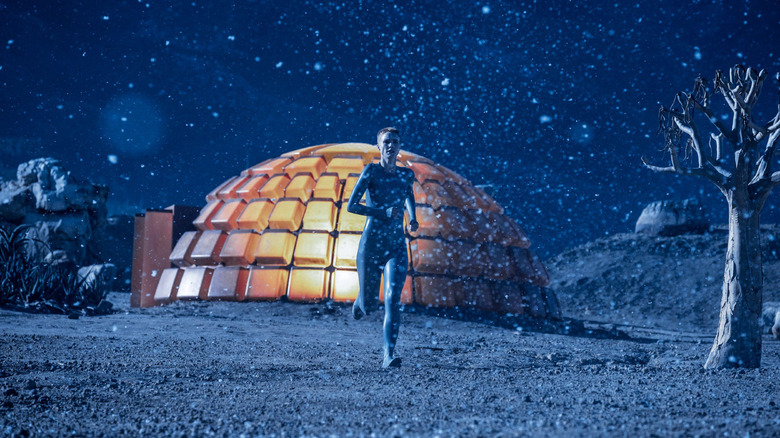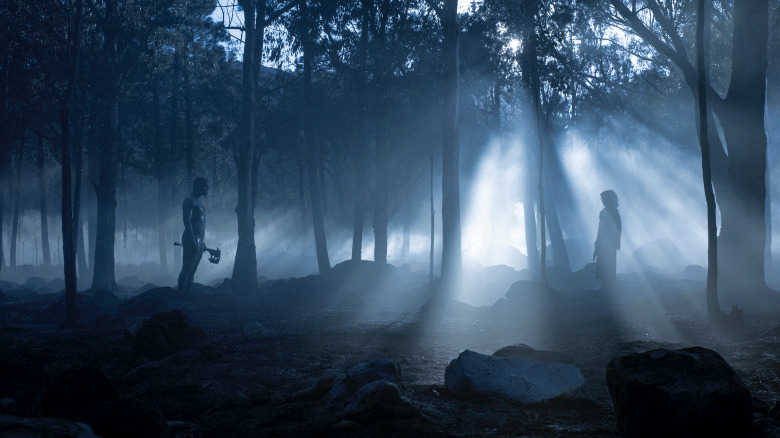
There's a fine art to crafting night scenes in films. A fair number of modern Hollywood blockbusters are guilty of combining poorly-lit moments set at night with toned-down color palettes, the results of which are movies that just look kinda murky and bland (with certain exceptions, natch). It's part of why so many people have gone wild for an international epic like "RRR," a film where a fair amount of the action takes place under the cover of night, yet it always manages to be lit in a bold and vivid fashion. But what about the movies that go to the opposite extreme, blending stylishly inky shadows in their night scenes with an almost monochromatic look?
Enter Ridley Scott, an aficionado when it comes to creating desaturated images that are actually enticing to behold. The "Alien" and "The Martian" director carried that over into Aaron Guzikowski's "Raised by Wolves," a sci-fi series which Scott executive produced on top of helming the first two episodes. In keeping with the latter's preference for utilizing practical effects and real-world locations as often as possible, much of the show's setting — the extrasolar planet Kepler-22b — was brought to life using hand-built sets shot at a remote spot in South Africa. That includes the base camp where the show's android leads, Mother and Father, and the human children they're tasked with raising reside for most of season 1.
Among those who joined Scott behind the camera on the show was Dariusz Wolski, who's served as the director's cinematographer since "Prometheus." Speaking to Sound & Vision, Wolski described the series as being "not dark, it's just very desaturated," in keeping with Scott's aesthetic. Still, "Raised by Wolves" is pretty dark (visually and thematically), enough so as to necessitate using an old-school technique to avoid filming at night.
Day For Night

Over the course of movie history, filmmakers have found different ways of getting around the challenges of shooting at night. In the days of silent cinema, night scenes were shot the same as any others and merely tinted blue to indicate the time of day (as is the case in most restored versions of "Nosferatu"). In later decades, however, they would use a trick known as "day for night," where the exposure on the camera is lowered to create the illusion of a scene being shot at night. Among the more famous examples of this is the famous opening to "Jaws," which is also why all the publicity stills and behind-the-scenes photos from this moment were clearly taken during the day.
"When you light at night, you can only see so much," said Dariusz Wolski, explaining to Sound & Vision why "Raised by Wolves" uses this same technique for its own night scenes. "And those mountains [near where we filmed] were so spectacular, it just allowed us to give the image a full dimension. So the nights are very twilightish." Wolski went on to note that the show's alien backdrop afforded them some "artistic license" in this respect, so far as what Keppler-22b looks like when the sun is down. Ridley Scott's son Luke Scott, who also directed several episodes of the show, agreed, pointing out:
"Keppler had two moons and three suns. So who's to say that night on a distance planet wouldn't look like that."
The results speak for themselves: "Raised by Wolves" is one of the most stunning-looking (check that, stunningly bleak-looking) series to ever make its way to the small screen. Despite being cut down in its prime, the show's two seasons are worth streaming on HBO Max, should you be so inclined.
Read this next: Single-Season '80s Sci-Fi And Fantasy Shows That Deserve A Second Shot
The post Raised By Wolves Relied On An Old-School Trick To Never Film At Night appeared first on /Film.
0 Comments